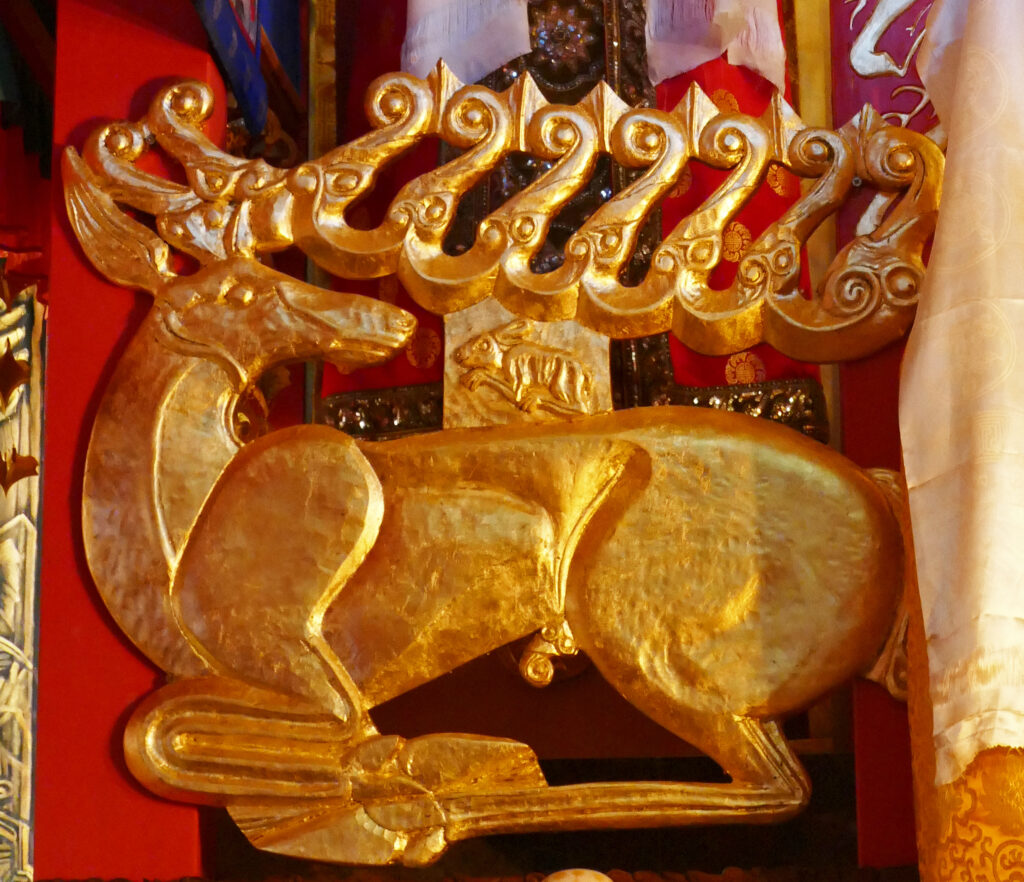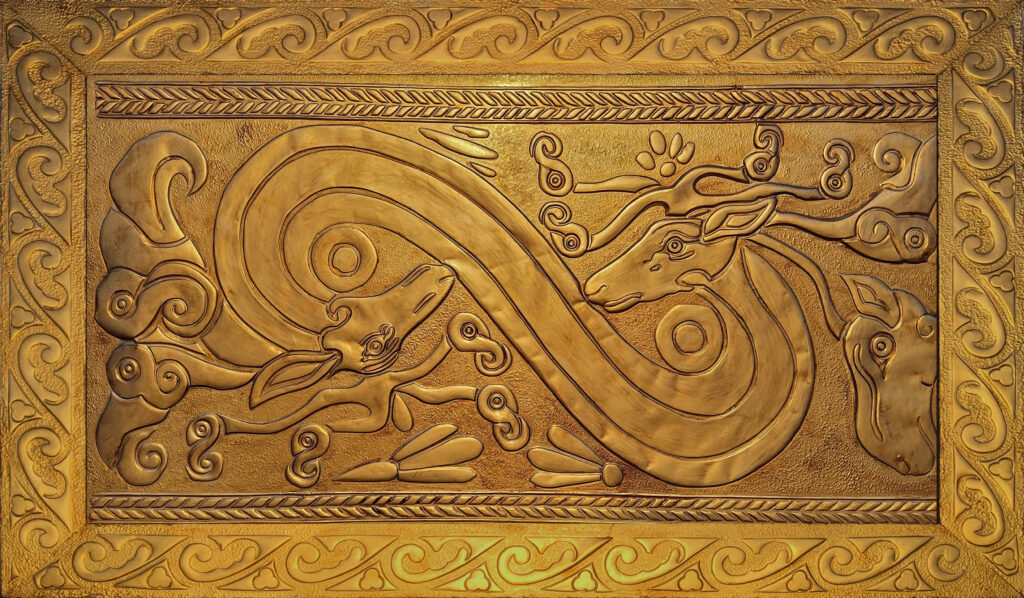The deer is one of the most important symbols in the whole Scythian-Hun spirituality. It is the mount, or carrier, of many enlightened beings, gods and guardians.
Enlightened beings, masters and gods take its form when they meet people. It is the mount of the gods on which they ascend to the upper worlds. We Hungarians derive our origin from Nemrot, the celestial hunter, and his two sons, Hunor and Magor, who were guided by a wonderful beast, the miraculous stag. According to the Inner Path, the miraculous stag is the messenger of the enlightened ones.

The Miraculous Deer in the Hungarian and Tibetan Spirituality
Our sacred animal that guides our ancestors, the deer, is one of the most important symbols in Scytho-Hun spirituality, and is found in many cultures of Eurasia.
The deer also plays an important role in Tibetan Buddhism and Bön. It is the mount, or carrier, of many enlightened beings, gods and guardians. Enlightened beings, teaching masters and gods take the form of the deer when they meet people, teach, guide and help them. He is a messenger of enlightened beings and gods who bring miraculous messages to people.
Two-headed Deer
The two heads of the deer mean that one head is in the heavenly realm of the enlightened ones, and the other is in our human world. The fact that it has one body means that these two worlds are inseparable. The seed of the enlightened nature resides in our hearts.

The deer in Buddhism and Bön
The Buddha gave his first teachings in the deer grove at Sarnath, where his audience included deer. In one of his earlier lives, the future Buddha himself took the form of a deer to help the animals of the forest. It is the beloved animal of the Bodhisattva of Compassion, Chenrezig (Sanskrit: Avalokitesvara), who never kills. The fact that this bodhisattva’s left shoulder is adorned with a deerskin, symbolising his deer-like gentleness, reminds us of our “Miraculous Deer-boy”.
The stag is the mount on which the táltos-priests ascend to the upper worlds. In a song by the great Tibetan Buddhist yogi Milarepa, he describes the Bönpo master Naro Bönchung riding a deer skin drum towards the summit of the sacred Mount Kailash. In the Tibetan deer dance, he is the messenger of the protectors, a living symbol of the magic power that destroys harmful forces. In his dance, he cuts the symbol of the evil forces into pieces, then transforms the harm into a beneficial force and scatters it in all directions of the compass.
The Primordial Deer in Bön
The conch-white, crystal-antlered miraculous deer is born by miracle, by revelation, at the very beginning, at the border between being and non-being, and brings into the world the life-giving quintessence (tib. Phya) of people, animals and things, and the inner richness (tib. g.yang) that distinguishes man from savage, horse from wild ass, cow from wild yak, and that gives warmth to clothing, nourishing power to food, brilliance to turquoise.
Homage to the presence of the phywa (= phya) bön and the g.yang bön!
First, as for setting out the base for the phya of the phenomenal world, [recite as follows]:
Kya’i! When the sky first came into being,
at the beginning of the world-ages,
at the boundary of being and non-being,
there came into existence
a white conch-shell deer with crystal antlers.
What came into existence?
It was the first of the world-ages that came into existence;
what descended?
It was phya and g.yang that descended.
Call “kha’i” to summon that phya undefeated;
call “kha’i” to summon the g.yang undefeated!
There was an emanation from that deer’s heart,
and from the head of that emanation
there came into existence
the phya castle [called] gYang Heart…
From the right antler of that emanation
there came into being the long bright spear for the top,
and from that there came into existence
the five pho wal siblings…
From the left antler of that emanation
there came into being
the mothers’ life-force spindle
with the turquoise whorl (lit. leaves),
and from that there came into existence
the five mo wal siblings…
The deer explains “in clear human speech”
that its father is a manifestation of the god gNam lha dkar po
and its mother a manifestation of dMu btsan rgyal mo,
and that the lha-lake and the dmu-crag
are respectively its soul lake and soul-mountain.
“Listen, Conch-shell Deer with Crystal Antlers!
You are the deer in which all qualities are combined:
the five points on each of the antlers
that grow on your head signify
the presence of the five families of gsas lords;
the jewelled whorl in your forehead signifies
the presence of the Celestial Head-ornament (Mu ye pra phud);
the ridge of your neck and so forth signify
the presence of the five nor lha siblings
in the council of the gods;
the fact that you speak in a human voice signifies
communication from gods to men;
your whiteness, brighter than conch, signifies
the clearing away of karmic residues;
your four iron hooves signify
the drying-up of the four demonic rivers;
the fact that you eat medicinal leaves signifies
liberation from physical illnesses.
Since all qualities are represented in you,
please, come for the phya of humans!”
The Sky Deer
The Sky Deer, also known as the Celestial Deer or the Sun Deer, is a mythical creature that holds significant cultural and spiritual importance in Central Eurasia, in the Scythian tradition. It is often depicted as a benevolent and sacred being, associated with celestial powers, mediation, and prosperity.
In Scythian mythology, the Sky Deer is seen as a mediator between the human realm and the celestial realm. It is believed to possess the ability to travel between the different dimensions of the universe, delivering messages and blessings from the gods to humans. This symbolism of the Sky Deer as a celestial messenger aligns also with its role in shamanic practices, where it is often invoked to connect with the spirit world.
Deer Cult in Central Eurasia
The Sky Deer’s symbolism extends beyond its association with the heavens and encompasses the concept of fertility and abundance. Its antlers, often depicted as multiple or branching, symbolize prosperity and growth, strength and longevity. linking the deer to the cycle of renewal and regeneration.
The Sky Deer’s association with prosperity is reflected in its depiction on various artifacts and ritual objects, including clothing, amulets, and paintings. Images of the Sky Deer are often found on the crowns and garments worn by shamans and ritual performers, symbolizing their connection to the divine and their ability to bring blessings and well-being.
The Sky Deer motif is also prevalent in rock art and petroglyphs across Central Eurasia, dating back to the Paleolithic period. These carvings often depict the Sky Deer soaring through the sky, accompanied by sun and moon symbols, reinforcing its connection to celestial realms and its role as a mediator between the earthly and cosmic domains.
The Sky Deer in Rituals and Myths
In the context of rituals, the Sky Deer is represented through the deer-crown, a headdress adorned with deer antlers or symbols of the deer. The deer-crown is worn by shamans and ritualists during ceremonies, embodying the power and essence of the Sky Deer and facilitating communication with the divine realm.
The Sky Deer plays a prominent role in Central Eurasian rituals and myths. During rituals, shamans often wear deer-skin cloaks or crowns to invoke the spirit of the Sky Deer and gain access to spiritual knowledge and power. In Scythian myths, the Sky Deer is often portrayed as a guide or companion to shamans and heroes on their journeys to the spirit world.
The Sky Deer, or “Heavenly Deer” is revered as a sacred animal, embodying wisdom, compassion, and the ability to traverse the boundaries between realms. The Sky Deer plays a central role in rituals and practices, often appearing as a symbol of guidance, protection, and prosperity.
In conclusion, the Sky Deer holds a prominent position in Central Eurasian cultures and spirituality, symbolizing celestial power, mediation, and prosperity. Its enduring presence in myths, art, and ritual practices attests to its deep-rooted significance in these traditions, reflecting the enduring human fascination with the divine and the interplay between earthly and cosmic realms.
